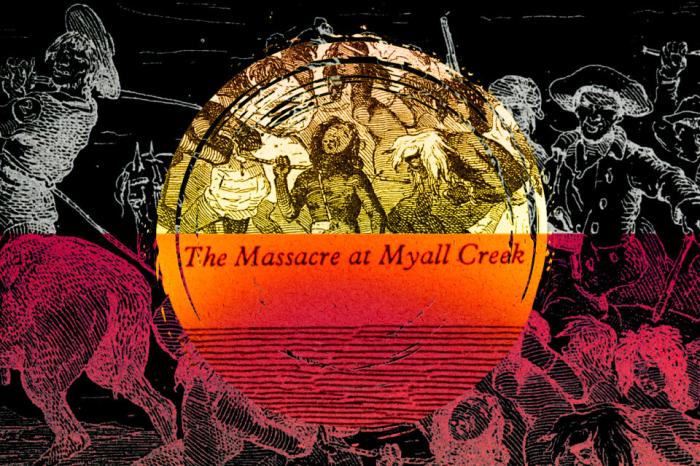Myall Creek Station Massacre - 1838 |

On June 10, 1838, 11 colonists (stockmen) and Charles Kilmeister massacred 28 women, children and men known as the Wirrayaraay, a tribal clan of the Kamilaroi nation.
This was not the first massacre in the so-called Frontier Wars and it would not be the last; the indiscriminate killing of First Nations people would continue for nearly a century after Myall Creek.
The events of 1838 can only be retold in detail today because the massacre was the first - and only - time in Australia when colonists were arrested, charged and prosecuted for the mass killing of Aboriginal people.
The details make horrific reading and utter shame for all Australians then, now and forever
Myall Creek apology
The Herald apologises for its coverage of the infamous 1838 Indigenous massacre after it advocated for the exoneration of nearly a dozen white murderers early in the masthead's history.
 The Herald has a proud history of telling Australia's story. But on Myall Creek, we failed dismally
The Herald has a proud history of telling Australia's story. But on Myall Creek, we failed dismally I've told many tales of tragedy, but never one as haunting as this
I've told many tales of tragedy, but never one as haunting as this The more you look, the more gruesome it gets': Coming to terms with a brutal Australian massacre
The more you look, the more gruesome it gets': Coming to terms with a brutal Australian massacre True heroes exposed the Myall Creek massacre. We don't know their names
True heroes exposed the Myall Creek massacre. We don't know their names As a descendant of the Myall Creek massacre, there is one story I cling to for hope
As a descendant of the Myall Creek massacre, there is one story I cling to for hope A code of silence that hid the mass killing of Indigenous people has now been broken
A code of silence that hid the mass killing of Indigenous people has now been broken This is the year Australia can lift a brutal burden from its heart
This is the year Australia can lift a brutal burden from its heartMyall Creek apology
EDITORIAL
The Herald has a proud history of telling Australia's story. But on Myall Creek, we failed dismally
As late afternoon light settled across Myall Creek Station in northern NSW on June 10, 1838, a cloud of dust appeared on the horizon as 11 stockmen rode over a hill and headed towards a group of women, children and elderly men known as the Wirrayaraay, a tribal clan of the Kamilaroi nation.
The clan sought protection in a hut occupied by two station employees, George Anderson and Charles Kilmeister, whom they had come to know and get along with. But the gang burst into the hut and used a rope to tie the Wirrayaraay together by their hands and lead them away. Under the threat of violence, Kilmeister betrayed the Wirrayaraay and assisted the stockmen. Anderson refused and would later give evidence in court about what was about to unfold.
The Wirrayaraay were marched away to a gully, where the stockmen slaughtered them in cold blood. Some were slashed or decapitated by swords and others trampled to death by horses. The 28 mangled bodies were thrown in a pile and burnt in an attempt to destroy any evidence of one of Australia's worst massacres. In a final act of depravity, the men kept one Indigenous woman to rape over the coming days.
This was not the first massacre in the so-called Frontier Wars and it would not be the last; the indiscriminate killing of First Nations people would continue for nearly a century after Myall Creek. But the events of 1838 can only be retold in detail today because the massacre was the first - and only - time in Australia when colonists were arrested, charged and prosecuted for the mass killing of Aboriginal people. So many other atrocities faded into nothingness, casualties of a culture of silence that has left us with an incomplete picture of our national story.
During the recent Lowitja O'Donoghue Oration, Prime Minister Anthony Albanese observed that we have lived through a silence, a long tide of denial gnawing away at our spirit. "We have to come to grips with the past because a country that does not acknowledge the full truth of its history is burdened by its unspoken weight," he said.
The Herald has a long and proud history of telling the Australian story. But on Myall Creek, the truth is we failed dismally.
In several editorials published before, during and after two Sydney trials in late 1838 relating to the massacre, the Herald essentially campaigned for the 11 accused mass murderers to escape prosecution. It also opposed the death sentence eventually handed to seven of the men. This was not due to a lack of evidence or genuine doubts over the integrity of any legal process, but because the perpetrators were white and the dead black. In one editorial published ahead of the trials and amid a public debate about legal protections for Aboriginal people, the Herald proclaimed: "The whole gang of black animals are not worth the money the colonists will have to pay for printing the silly documents on which we have already wasted too much time." The same editorial said the colony did not want "savages" to exist. "We have far too many of the murderous wretches about us already," the editorial declared. In another piece, the Herald encouraged readers to shoot and kill Aboriginal people if they ever felt threatened. The combined effect of the editorial approach helped support the proposition colonists should be entitled to impunity for violence against Aboriginal people.
The Herald's co-owner at the time, Alfred Ward Stephens, was a friend of one of the wealthy landowners who funded the defence of the 11 accused men.
In what appears to be a last-ditch effort to sabotage the convictions and death sentences, the Herald even raised the prospect that evidence had been discovered proving at least three of the murderers were never at Myall Creek. As Company of Heralds - a book documenting the history of the masthead - would later note, either the Herald had been misled or it had knowingly put forward a fabrication. "The latter seems more likely," the book's author, Gavin Souter, concluded.
While it is true that the majority view of the colony was probably against the prosecutions, historians believe the Herald's position was still something of an outlier. It cannot be dismissed merely as an "of its time" reflection of the era.
We know this because other newspapers - which have long ceased publishing - had a much more respectful view about the trials and the notion Aboriginal people were entitled to the same legal protections as British subjects. The Herald's thinking was also out of step with key members of the NSW political establishment such as governor George Gipps and attorney-general John Hubert Plunkett, who spearheaded the effort to bring the murderers to justice.
Myall Creek has weighed on the Herald's conscience for some time; even a book published in 1931 to mark the Herald's 100th anniversary, titled A Century of Journalism: The Sydney Morning Herald and its Record of Australian Life, concluded the masthead's early attitudes towards Australia's original inhabitants "is a matter which the reader of today must find it hard to understand or to forgive". Company of Heralds also declared our coverage of Myall Creek and other incidents involving Aboriginal people was "as brutal as colonial journalism gets".
While the damage had already been done, thankfully the Herald's attitude towards Indigenous Australians shifted markedly in the 1840s.
As Australia prepares for a referendum on constitutional recognition for Indigenous Australians later this year, the nation is thinking deeply about what reconciliation looks like in 2023. So too is the Herald. We agree truth is an essential force for reconciliation, and on the 185th anniversary of the Myall Creek massacre offer an apology for our coverage of the slaughter and two subsequent trials.
Our decision today is not without precedent; Herald readers will recall our 2016 apology for the hurt and suffering caused by the publication of the names, addresses and professions of 53 people arrested during the 1978 Mardi Gras. The Guardian in Britain also recently apologised for its founders' links to transatlantic slavery, while several mastheads in the United States such as the Los Angeles Times and The Baltimore Sun have publicly apologised for past failings on race reporting.
Some may question the need to apologise for history. We acknowledge that today's generation is not responsible for the sins of earlier ones, yet we can help heal old harms nonetheless. We also respectfully argue that the capacity to recognise a past wrong is a sign of a strong future.
When a committee of Indigenous elders and non-Indigenous locals set about building a memorial at the Myall Creek massacre site in the late 1990s, they wrote a fitting statement that rings just as true today: "If we and our descendants are to live in peace in Australia then we have to tell and acknowledge that truth of our history. It is not that all of our history is bad, but the bad must be acknowledged along with the good, if we are to have any integrity."
It is in this spirit that we today seek to right the Herald's historic wrong.
Source: theage.com.au
The Herald has a proud history of telling Australia's story. But on Myall Creek, we failed dismally
June 9, 2023
❊ Address ❊
⊜ Myall Creek Station Myall Creek View Map
❊ More Information ❊
→
www.theage.com.au
❊ Also See.. ❊
➼ History of Sydney
Update Page








